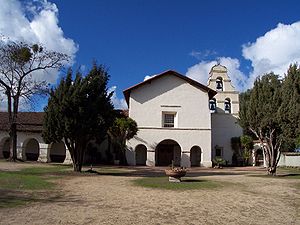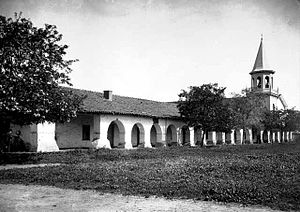- Mission San Juan Bautista
-
Other missions bearing the name San Juan include the Misión San Juan Bautista Malibat (Misión Liguí) in Baja California Sur and the Misión San Juan Bautista in Guerrero, Coahuila, Mexico.
Mission San Juan Bautista 
A view of the restored Mission San Juan Bautista and its added three-bell campanario ("bell wall") in 2010. Two of the bells were salvaged by Father Nick Senf in 2009 from the original chime, which was destroyed in the 1906 San Francisco earthquake.Location 406 2nd Street
San Juan Bautista, California 95045Name as founded La Misión del Glorios Precursor de Jesu Cristo, Nuestro Señor San Juan Bautista [1] English translation The Mission of the Glorious Precursor of Jesus Christ, Our Lord Saint John the Baptist Patron Saint John the Baptist [2] Nickname(s) "Mission of Music" [3] Founding date June 24, 1797 [4] Founding priest(s) Father Fermín Lasuén [5] Founding Order Fifteenth [2] Military district Third [6] Native tribe(s)
Spanish name(s)Mutsun, Yokuts
CosteñoNative place name(s) Popeloutchom [7] Baptisms 4,106 [8] Marriages 1,003 [8] Burials 2,854 [8] Secularized 1835 [2] Returned to the Church 1859 [2] Governing body Roman Catholic Diocese of Monterey Current use Parish Church Coordinates 36°50′42.3″N 121°32′9.2″W / 36.845083°N 121.535889°W California Historical Landmark #195 Website http://www.oldmissionsjb.org/ Mission San Juan Bautista was founded on June 24, 1797 in what is now the San Juan Bautista Historic District of San Juan Bautista, California. Barracks for the soldiers, a nunnery, the Jose Castro House, and other buildings were constructed around a large grassy plaza in front of the church and can be seen today in their original form. The Ohlone, the original residents of the valley, were brought to live at the mission and baptized, followed by Yokuts from the Central Valley. Mission San Juan Bautista has served mass daily since 1797.
Mission San Juan Bautista is the largest of the Spanish missions in California.[9] The mission was used in the 1958 Hitchcock film Vertigo, but the bell-wall was treated as a "bell tower" staircase, actually constructed on a studio lot.
Contents
History
Following its creation in 1797, San Juan's population grew quickly. By 1803, there were 1,036 Native Americans living at the mission. Ranching and farming activity had moved apace, with 1,036 cattle, 4,600 sheep, 22 swine, 540 horses and 8 mules counted that year. At the same time, the harvest of wheat, barley and corn was estimated at 2,018 fanegas, each of about 220 pounds. Father Pedro Estévan Tápis (who had a special talent for music) joined Father Felipe Arroyo de las Cuesta, at Mission San Juan Bautista in 1815 to teach singing to the Indians. He employed a system of notation developed in Spain that uses varied colors or textures for polyphonic music, usually (from bottom to top) solid black, solid red, black outline (sometimes solid yellow) and red outline (or black outline when yellow was used). His choir of Native American boys performed for many visitors, earning the San Juan Bautista Mission the nickname "the Mission of Music." Two of his handwritten choir books are preserved at the San Juan Bautista Museum. When Father Tapis died in 1825 he was buried on the mission grounds. The town of San Juan Bautista, which grew up around the mission, expanded rapidly during the California Gold Rush and continues to be a thriving community today. The structures suffered extensive damage in the earthquakes of 1800 and 1906; the mission was restored initially in 1884, and then again in 1949 with funding from the Hearst Foundation, and today continues to serve as a parish of the Roman Catholic Diocese of Monterey.
The mission and its grounds were featured prominently in the 1958 Alfred Hitchcock film Vertigo. Associate producer Herbert Coleman's daughter Judy Lanini suggested the mission to Hitchcock, as a filming location. A steeple, added sometime after the mission's original construction and secularization, had been demolished following a fire, so Hitchcock added a "bell tower" using scale models, matte paintings, and trick photography at the Paramount Pictures studio in Los Angeles. The mission was built immediately adjacent to the San Andreas Fault and has suffered damage from numerous earthquakes over the years, but it has never been completely demolished. An unpaved stretch of the original El Camino Real, just east of the mission, lies on a fault scarp.[10]
Notes
- ^ Bennett 1897b, p. 153
- ^ a b c d Krell, p. 241
- ^ Ruscin, p. 121
- ^ Yenne, p. 132
- ^ Ruscin, p. 196
- ^ Forbes, p. 202
- ^ Ruscin, p. 195
- ^ a b c Krell, p. 315: as of December 31, 1832; information adapted from Engelhardt's Missions and Missionaries of California.
- ^ NHL Summary for Historic District[dead link].
- ^ Robert Iacopi, Earthquake Country (Menlo Park:Lane Publishing, 2004, 1971).
See also
- USNS Mission San Juan (AO-126) — a Buenaventura Class fleet oiler built during World War II.
- Rancho San Justo
- Teatro Campesino
References
- Bennett, John E. (February 1897b). "Should the California Missions Be Preserved? - Part II". Overland Monthly XXIX (170): 150–161.
- Forbes, Alexander (1839). California: A History of Upper and Lower California. Smith, Elder and Co., Cornhill, London.
- Jones, Terry L. and Kathryn A. Klar (eds.) (2007). California Prehistory: Colonization, Culture, and Complexity. Altimira Press, Landham, MD. ISBN 0-759-10872-2.
- Krell, Dorothy (ed.) (1979). The California Missions: A Pictorial History. Sunset Publishing Corporation, Menlo Park, CA. ISBN 0-376-05172-8.
- Leffingwell, Randy (2005). California Missions and Presidios: The History & Beauty of the Spanish Missions. Voyageur Press, Inc., Stillwater, MN. ISBN 0-89658-492-5.
- Levy, Richard. (1978). William C. Sturtevant, and Robert F. Heizer. ed. Handbook of North American Indians. 8 (California). Smithsonian Institution, Washington, DC. ISBN 0-16-004578-9 / 0160045754, page 486.
- Milliken, Randall (1995). A Time of Little Choice: The Disintegration of Tribal Culture in the San Francisco Bay Area 1769-1910. Ballena Press Publication, Menlo Park, CA. ISBN 0-87919-132-5.
- Paddison, Joshua (ed.) (1999). A World Transformed: Firsthand Accounts of California Before the Gold Rush. Heyday Books, Berkeley, CA. ISBN 1-890771-13-9.
- Ruscin, Terry (1999). Mission Memoirs. Sunbelt Publications, San Diego, CA. ISBN 0-932653-30-8.
- Yenne, Bill (2004). The Missions of California. Thunder Bay Press, San Diego, CA. ISBN 1-59223-319-8.
- Since 2004, the mission has been fixed, and people can come visit Mission San Juan Bautista and look at it.
External links
- Mission San Juan Bautista - official site
- Early photographs, sketches, land surveys of Mission San Juan Bautista, via Calisphere, California Digital Library
- Vertigo at the Internet Movie Database
- Listing and photographs of church at the Historic American Buildings Survey
- Listing, drawings and photographs of mission at the Historic American Buildings Survey
California missions San Diego de Alcalá (1769) · San Carlos Borromeo de Carmelo (1770) · San Antonio de Padua (1771) · San Gabriel Arcángel (1771) · San Luis Obispo de Tolosa (1772) · San Francisco de Asís (1776) · San Juan Capistrano (1776) · Santa Clara de Asís (1777) · San Buenaventura (1782) · Santa Barbara (1786) · La Purísima Concepción (1787) · Santa Cruz (1791) · Nuestra Señora de la Soledad (1791) · San José (1797) · San Juan Bautista (1797) · San Miguel Arcángel (1797) · San Fernando Rey de España (1797) · San Luis Rey de Francia (1798) · Santa Inés (1804) · San Rafael Arcángel (1817) · San Francisco Solano (1823)
Asistencias
Nuestra Señora Reina de los Angeles (1784) · San Pedro y San Pablo (1786) · Santa Margarita de Cortona (1787) · San Antonio de Pala (1816) · Santa Ysabel (1818)Estancias
San Bernardino de Sena (1819) · Santa Ana (1820) · Las Flores (1823)Categories:- NRHP articles with dead external links
- Spanish missions in California
- San Juan Bautista, California
- History of San Benito County, California
- 1797 establishments
- California Historical Landmarks
- Properties of religious function on the National Register of Historic Places in California
- Roman Catholic Diocese of Monterey in California
- Buildings and structures in San Benito County, California
- Spanish Colonial architecture in California
- Museums in San Benito County, California
- Religious museums in California
- History museums in California
Wikimedia Foundation. 2010.

